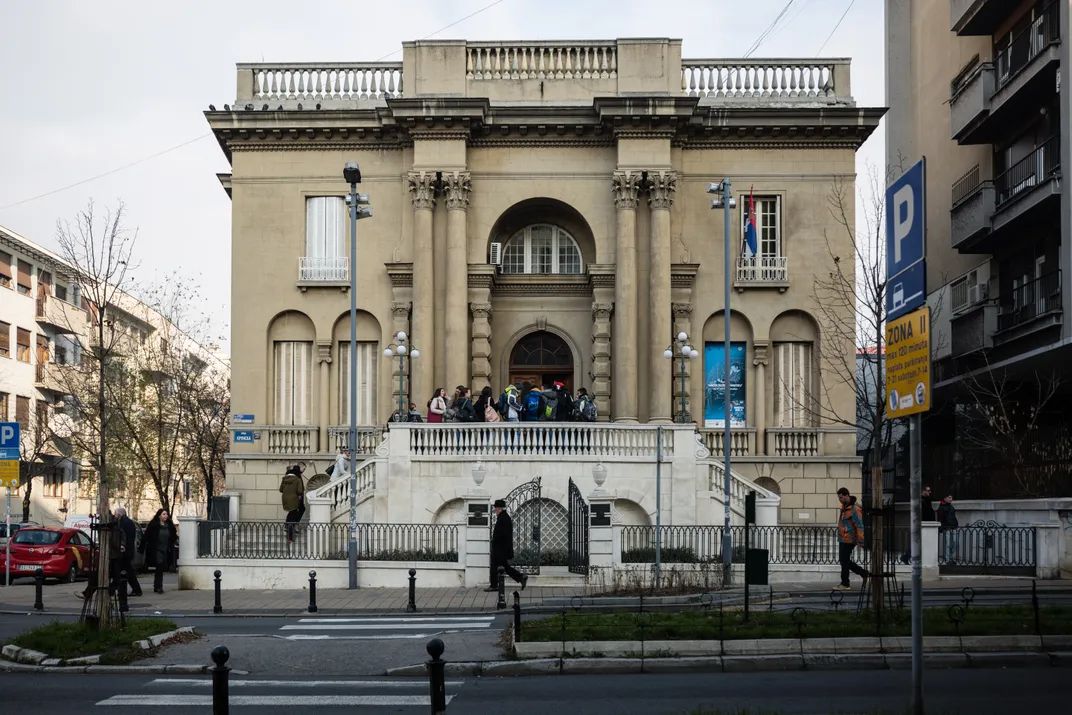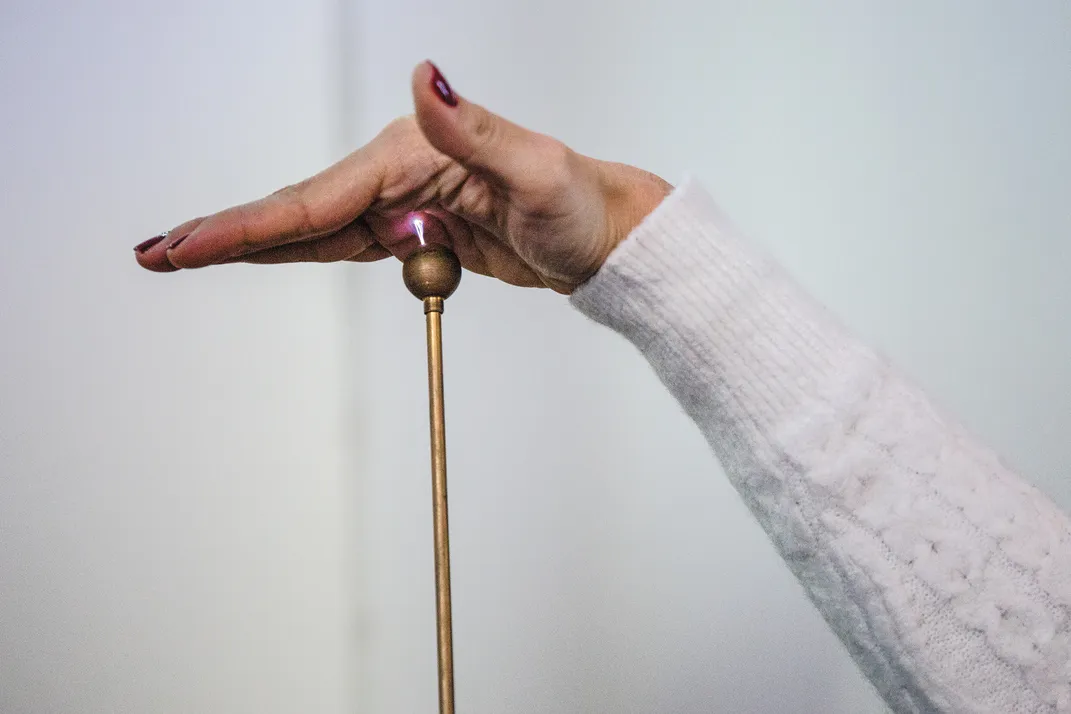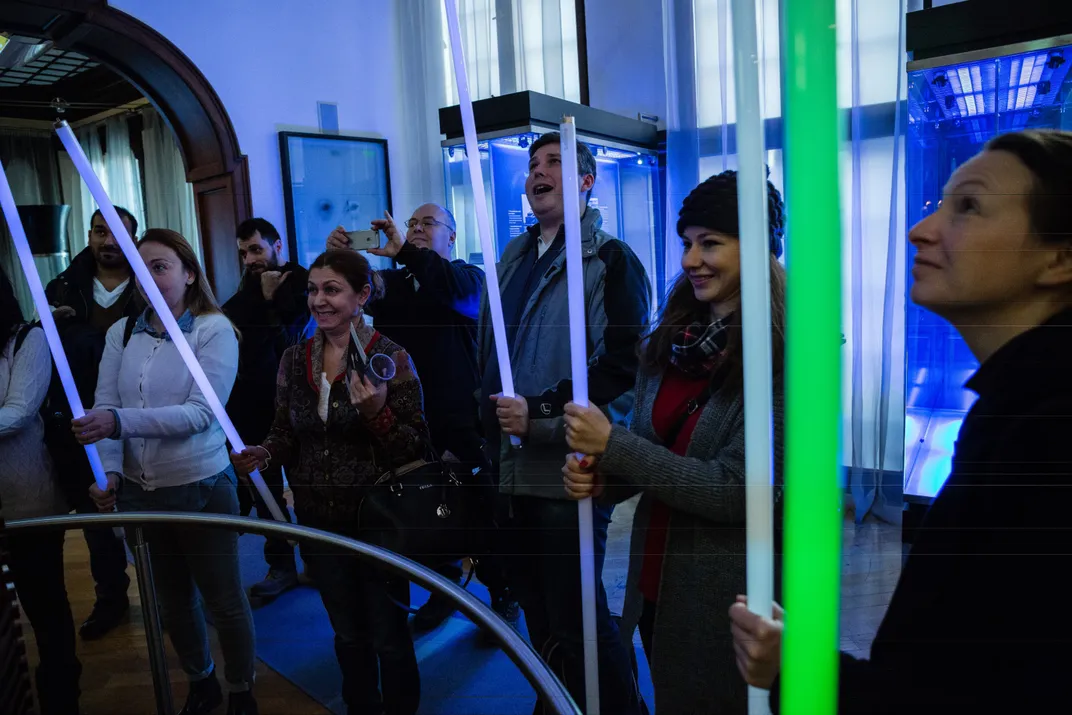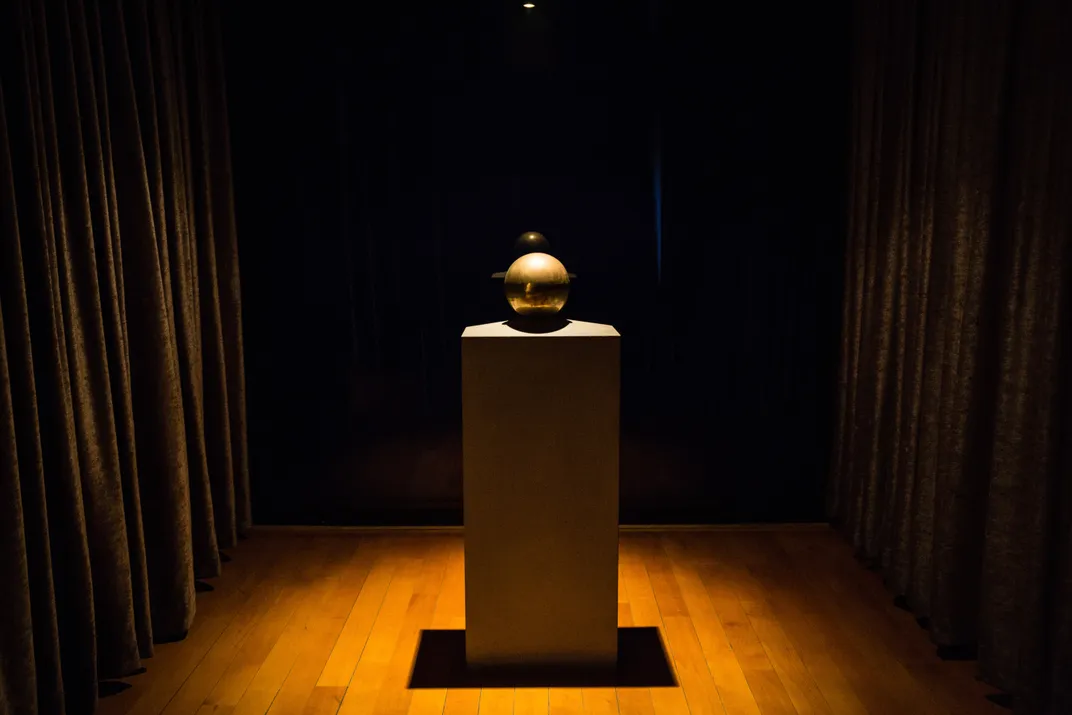Nikola Tesla’s Struggle to Remain Relevant
An offbeat Belgrade museum reveals the many mysteries of the prolific, late-19th-century inventor
:focal(2572x2722:2573x2723)/https://tf-cmsv2-smithsonianmag-media.s3.amazonaws.com/filer/15/97/15972379-a704-4c12-8848-196d954896dc/42-55992923.jpg)
Of the exhibits in Belgrade’s Nikola Tesla Museum, perhaps the most telling contains Mr. Tesla’s brown suit, which hangs in a glass case in the front room. With its natty, old-fashioned styling punctuated by the dapper brown trilby hovering over the space where his head ought to be, the disembodied ensemble recalls an illustration for Ralph Ellison’s Invisible Man. It’s a slightly unsettling but apt metaphor for the brilliant Serbian inventor and futurist who arguably did more to shape and foretell the 20th century than anyone, yet who remains a largely forgotten historical footnote.
Nikola Tesla did not always labor in obscurity. For a fleeting decade or so around the turn of the century, he was the toast of America, the country to which he’d emigrated in 1884. Feted by the press and showered with gold medals and awards from learned institutions and universities, he threw dinner parties at Delmonico’s in New York, entertained crowds with showy electricity demonstrations, and counted J.P. Morgan, John Jacob Astor, and Mark Twain among his many famous acquaintances.
For it was Tesla’s genius that solved the problem of how to distribute electricity safely and efficiently to homes, shops, and factories—something that had defeated Thomas Edison. With that innovation, he helped usher in a whole new industrial age. He additionally gave the world its first, functional electric motor: Whenever a vacuum cleaner clatters to life, a laptop powers up, or an overhead light is turned on, the technology used can be traced back to Tesla.
In one golden decade beginning in 1893, he pioneered radio technology some two years ahead of Guglielmo Marconi, created the world’s first x-ray images, and conceived the idea of radar. While the late 19th-century world became enthralled with the wondrous new age of hydroelectric dams, power lines, and electric lighting available at the flick of a switch, Tesla continued to leapfrog ahead. He invented the bladeless turbines used in modern jet engines and imagined a wireless future in which information, music, pictures, and limitless renewable energy could be beamed around the globe instantly, free, and available for all.
Tesla was already powering fluorescent lamps—another of his inventions—using wireless technology by the early 1890s. In his laboratory, he also designed the antennae that would be used in mobile phones a century later. His showy demonstration of a radio-controlled boat at New York’s Madison Square Garden wowed the crowd with a taste of what the wireless future would hold.
So how did such a brilliant, successful inventor end up, many years later, an obscure figure feeding pigeons in a park, dying destitute and alone in a New York City hotel room in 1943? “Tesla was simply too far ahead of his time,” says Branimir Jovanovic, the director of the Nikola Tesla Museum. “And although he was a brilliant inventor, a genius, he was a naive businessman who was hopelessly out of step with commerce and 19th-century American capitalism.”
Tesla never married nor had children. His nephew, the only relation with whom he maintained any form of contact, shipped his late uncle’s immense collection of papers, drawings, letters, and photographs to Belgrade in 1952. Only too happy to celebrate a home-grown hero, Yugoslavia’s communist authorities opened the Tesla museum inside a handsome villa soon after. There the collection and museum remain, easily the largest repository of Tesla memorabilia in the world. “For decades his legacy was sealed away behind the Iron Curtain,” says Jovanovic. “Western historians had virtually no opportunity to research Tesla or gain any deeper understanding of his work. As the years passed he became almost forgotten.” But now, as the Cold War recedes into distant memory, that is changing.
**********
If Tesla was largely forgotten by his adopted country, Serbia remembers him as one of their own. His name adorns Belgrade’s airport, while Nikola Tesla Boulevard hugs the Danube in the new part of the city. His portrait graces postage stamps and the Serbian 100-dinar note. His likeness in bronze stands outside the University of Belgrade’s School of Electrical Engineering. Tesla-themed T-shirts, postcards, fridge magnets, lapel pins, and coffee mugs crowd the souvenir kiosks along the Knez Mihailova, the shopping precinct in the old quarter of the city.
The rather idiosyncratic Nikola Tesla Museum at Krunska 51, an address on a quiet side street in the heart of Belgrade, has become a popular draw for science history buffs, geeks, and electrical
engineers. Increasingly it also attracts the broad spectrum of tourists for whom the Tesla name rings a bell, more often than not in association with PayPal billionaire Elon Musk’s electric smart car, just the sort of invention that Tesla himself would have loved. The museum contains more than 160,000 original documents, ranging from detailed plans Tesla made of various electrical apparatus and instruments to Christmas cards he received from his many fans and admirers. Even the man himself is present—or rather his ashes are, sealed in a gold-plated orb and displayed, rather eerily, in a small chapel-like side room, draped in black, just off the main gallery.
For non-technical visitors and those unfamiliar with the Tesla story, the museum offers a short film in English as well as guides that explain the concepts behind various models of Tesla’s inventions, including the 500,000-volt Tesla coil with which he created lightning bolts in his Colorado laboratory. (Plans are afoot to build a much larger 12-million-volt Tesla coil, which he used to generate the largest human-made electrical charge ever seen on the planet until modern times.) Both of these instruments were part of Tesla’s research into the possibility of using the Earth itself as a giant conductor to produce unlimited amounts of renewable energy—a concept theoreticians still debate today.
Born during a fierce electrical storm in what is now Croatia, in June 1856, Tesla had his interest in electricity sparked (so to speak) as a child by the little shocks of static he experienced while stroking his pet cat, Macak. Comparing in his mind the prickly little sparks that sprang from Macak’s fur, and the great bolts of summer lightning that criss-crossed the sky, he wondered, as he put it in his autobiography many years later, “if nature was like a giant cat.”
Curiosity and a boyhood love of invention led him to engineering schools in Austria and Czechoslovakia. His peripatetic professional career began in Budapest, where he worked as chief electrician for a fledgling telephone company. He then moved to Paris to take a job with Edison’s European operations. In June 1884, he arrived in New York City, clutching a letter of introduction to Edison himself. “I know two great men,” wrote Edison’s long-time associate and talent spotter, Charles Batchelor. “You are one. This young man is the other.”
The two men proved polar opposites. Their relationship soon soured, with Edison allegedly reneging on a promise to pay Tesla $50,000 for some dramatic, hard-won technical improvements that the young engineer had made to the designs for Edison’s dynamos. It would not be the last time that Tesla came off second best in a business deal. “Being an honest man himself, Tesla trusted nearly everyone he met,” says his biographer Robert Lomas. “And almost all of them ripped him off.”
“How quickly will I get my investment back was a question Tesla was not even prepared to consider,” Lomas explains. “He was working for the betterment of mankind—who could put a price on that?” Many others had no problem contemplating rich rewards for their work, among them Edison and the entrepreneurial inventor George Westinghouse, as well as the billionaire financier J.P. Morgan, all of whom figure prominently in the Tesla story.
In the 1890s Edison’s and Westinghouse’s companies became bitter rivals in the “War of the Currents,” a multi-million-dollar race to electrify America. Edison backed the use of direct current, or DC, in which electricity flows only in one direction within a circuit. Direct current could power lights and run machines, but could not be easily converted to higher or lower voltages, necessitating low-voltage transmissions that didn’t reach more than a mile. This meant power stations would need to exist every few blocks throughout a city. Westinghouse supported alternating current, or AC, in which electrical current periodically changes direction in a circuit. High-voltage AC could travel long distances, but difficulties remained about how to step high voltages down to levels useable in homes and businesses once it arrived. Into this bitter contest strolled Tesla, who had spent years trying to interest investors in his ingenious designs for AC transformers, electrical devices that could increase or decrease voltages.
Westinghouse embraced the Serb’s ideas, eventually parlaying Tesla’s expertise into a contract to electrify the Chicago World’s Fair in 1893. Two years later, Westinghouse built a hydroelectric plant of gargantuan proportions, harnessing the power of the Niagara River to light up Buffalo, New York. “Of the thirteen patents involved in the design, nine were Tesla’s,” says Jovanovic.
Such innovations might have made Tesla rich, but they merely made him comfortable, able to host his dinner parties at Delmonico’s, dress stylishly, and invest in new research. Needing cash to develop the next big thing—wireless technology and renewable energy from the Earth itself—he sold for a modest sum the patents, rights, and royalties for his AC motor to the Westinghouse Electric Corporation. “He lived in a world of ideas,” says Lomas. “He loved to build mental models of his inventions and imagine them working. If you asked him how much it cost to make, he’d point to the elegance of its rotating magnetic field; if you asked how many people would want to buy it, he would demonstrate how efficient it was.”
At a secluded site in Colorado, he launched a series of experiments, then announced plans to build a huge transmitting tower at a site called Wardenclyffe on Long Island. Rather naively, he approached J.P. Morgan for additional investment capital, excitedly painting a picture of a nation powered by free, abundant, and wireless electricity. One can only wonder what Morgan must have been thinking as he listened to Tesla’s pitch. The hard-nosed businessman had already sunk millions into networks of expensive copper wires to carry electricity. Nonetheless, Morgan gave Tesla $150,000.
“It sounds like a lot of money, and indeed it was—to Tesla,” says Jovanovic, “but not to Morgan. He spent that much the following week on a painting. He was just protecting his investments by making sure he was in control of whatever Tesla came up with.” In return for the cash, Tesla signed over rights to any patents that resulted from his new wireless research.
Believing he was on the threshold of great things, Tesla began building his Long Island tower. But he soon burned through the money, returning to Morgan for more. This time the financier refused him outright. And no, Morgan would not relinquish rights to Tesla’s future wireless patents. In addition, Morgan told others in merchant banking circles that he considered Tesla a bad investment. Tesla’s prospects for raising capital dried up virtually overnight. “It took a while to sink in, but Tesla eventually realised he had made a big mistake,” says Jovanovic.
The museum chronicles Tesla’s flirtation with wireless technology at the pinnacle of his career. Displays explain how the enormous coils he built generated huge quantities of electricity, along with images of the enormous mushroom-shaped telecommunications tower he was building on Long Island. But by 1905, Tesla was a changed man. “It is as though there were two Tesla’s—the eager young emigrant who, for a while at least, lived the American dream, and the embittered older Tesla who had learned life’s lessons the hard way,” says Jovanovic, himself an aeronautical engineer, who has spent years studying the inventor and recently wrote a book about him in Serbian.
The museum’s gallery of photos shows both of Tesla’s personas, the mesmerizing young man with a touch of mischief in his eye and the humorless 61 year-old. By the time he received the Edison Medal in 1916 for his electrical engineering achievements, his fame rested as much on his sensationalist claims and predictions in the tabloid press as it did on his legitimate engineering feats.
In a desperate bid to remain relevant, he wrote increasingly bizarre articles on almost any subject. He still turned out clever inventions, shifting to the field of mechanical engineering, and giving the world the speedometer and tachometer, but his glory days were over.
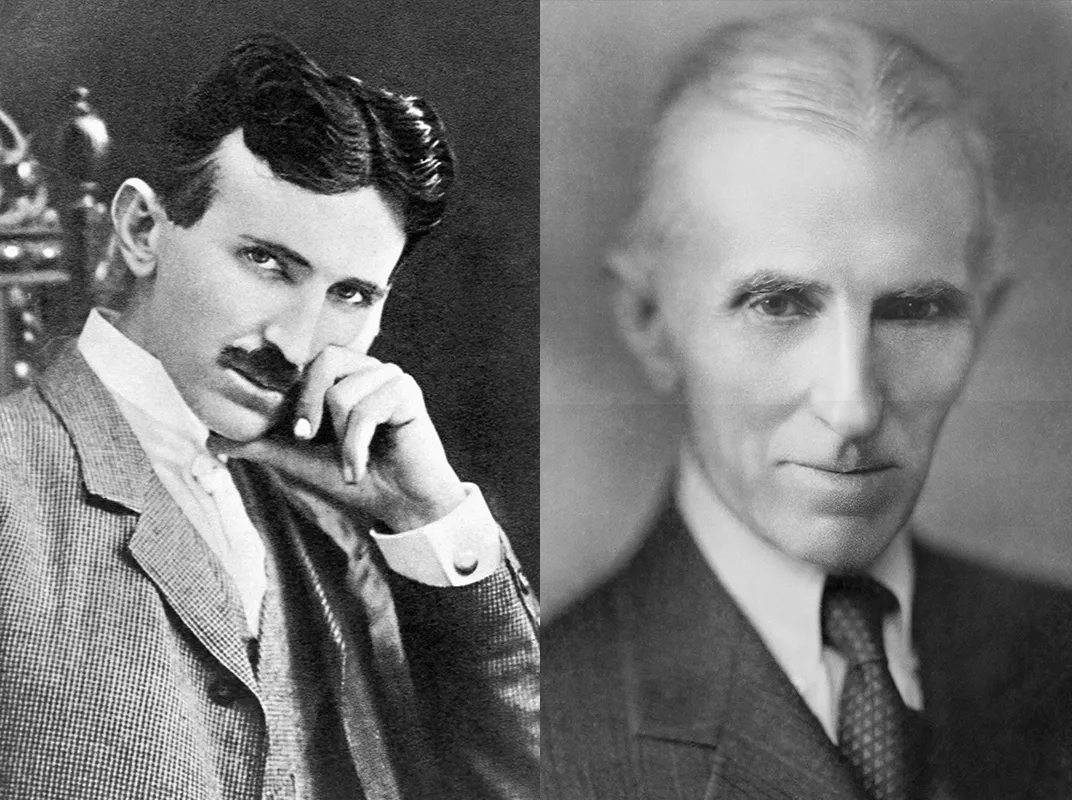
**********
Today, there are signs of growing interest in Tesla. More and more academics have been tapping into the museum’s rich trove of material. For its part, the museum has plans to launch a new website later this year, detailing its holdings so that researchers can apply for access. Museum curators mounted an exhibition that traveled to Spain and Mexico over the past year; another exhibition will soon open in Ljubljana, Slovenia, and yet another will debut in Belgrade in July to mark the 160th anniversary of Tesla’s birth. The latter will feature 50 new interactive exhibits based on Tesla’s original patents and designs. There is talk about building a much larger Tesla museum complex along the Danube, which would not only house the museum’s entire archive, but also interactive exhibits and 300 models of his inventions.
But his life and work are still swept up in a sci-fi fantasy that was present even during his lifetime, thanks to his showmanship and willingness to play the mad scientist to gain attention and column inches in the press. Legends of the immigrant abound—from the KGB’s supposed interest in spiriting away Tesla’s top secret research regarding a “death ray” after his death, to the FBI’s suppression of his papers to prevent his “secret” inventions from being blurted out to the world. In a 2006 fantasy thriller, The Prestige, David Bowie plays the role of Tesla depicted as a genius Victorian inventor who creates a Star Trek-style teleporter for a sinister magician. “It is important to remember the real Tesla,” says Jovanovic, “and to celebrate what he accomplished.” The museum at Krunska 51, in Belgrade, with its old Christmas cards and family photos goes a long way towards fleshing out the figure in the empty brown suit.
